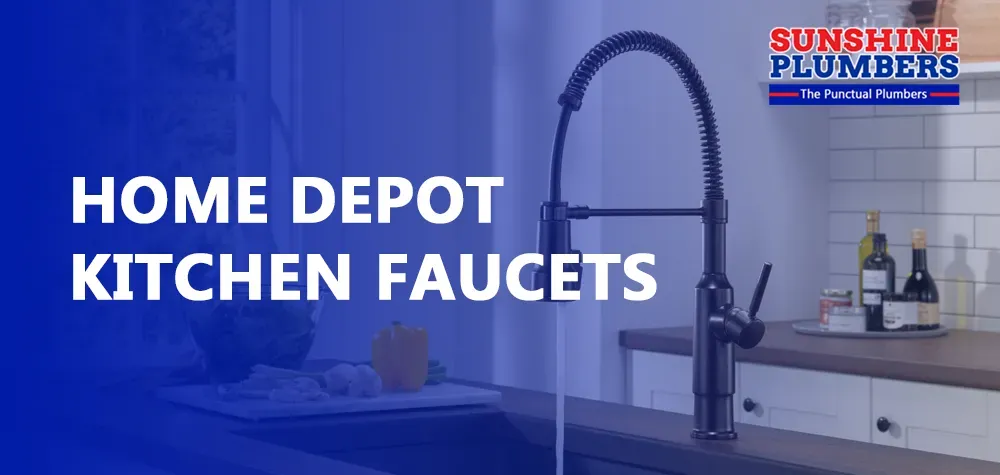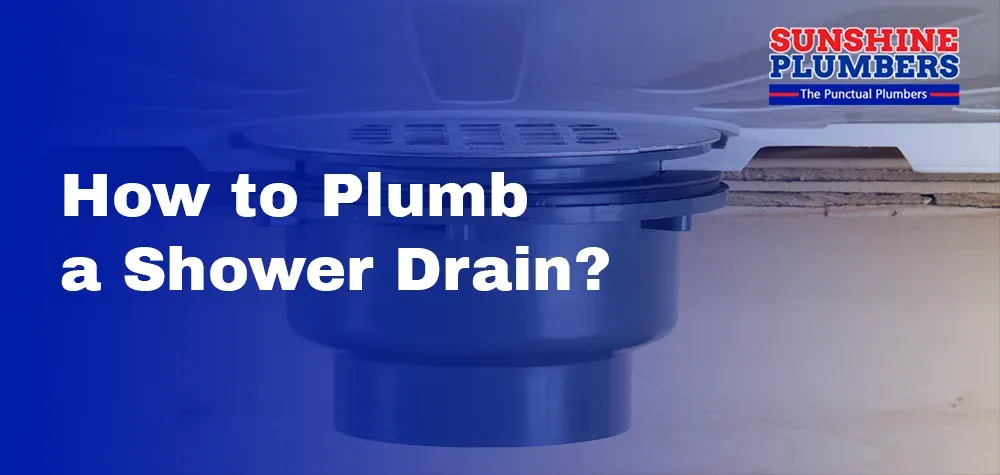How to Plumb a Shower Drain?
Are you planning to install or replace a shower drain and wondering how to do it correctly? Plumbing a shower drain may seem daunting, but with the right guidance, you can tackle this task like a pro. At Sunshine Plumbers, we're here to provide expert advice and walk you through the process of plumbing a shower drain efficiently and effectively. In this comprehensive guide, we'll cover everything you need to know to ensure a successful installation and keep your shower draining smoothly.
Comprehensive Guide
Gather the Necessary Tools and Materials:
- Before you begin plumbing the shower drain, make sure you have all the required tools and materials on hand. These may include:
- The shower drain assembly kit
- PVC or ABS drain pipe
- Pipe wrench
- Hacksaw
- Screwdriver
- Silicone caulk
- Plumber's putty
- Measuring tape
Prepare the Shower Drain Area
Before diving into the installation process, it's crucial to adequately prepare the shower drain area to ensure a smooth and successful installation. Here are some additional steps to consider:
- Remove the Old Drain Thoroughly: Take the time to remove the old drain carefully, especially if it's worn out or damaged. Use a screwdriver or wrench to loosen and remove any screws or fittings holding the old drain in place. Ensure that all remnants of the old drain, including any sealant or debris, are completely cleaned out of the drain opening.
- Inspect the Subfloor or Shower Base: Once the old drain is removed, inspect the subfloor or shower base for any signs of damage, such as rot or water damage. Repair any issues as necessary to create a solid and stable foundation for the new shower drain installation.
- Clean and Clear the Drain Opening: Thoroughly clean and clear the drain opening of any remaining debris, grime, or old sealant. Use a brush, sponge, or cleaning solution to remove any buildup and ensure a clean surface for the new drain installation.
- Measure and Verify Drain Opening Dimensions: Take accurate measurements of the shower drain opening to ensure compatibility with the new drain assembly. Double-check the dimensions to avoid any discrepancies and ensure a proper fit during installation.
By taking these additional steps to prepare the shower drain area, you'll create a solid foundation for the installation process and help prevent potential issues down the line.
Install the Shower Drain Base
Installing the shower drain base is a critical step in the process of plumbing a shower drain. Here's how to ensure a secure and watertight installation:
- Apply a Generous Bead of Silicone Caulk: Before placing the shower drain base or flange over the drain opening, apply a generous bead of high-quality silicone caulk around the underside of the flange. This creates a watertight seal between the drain base and the shower base or subfloor, preventing leaks and water damage.
- Position the Flange Carefully: Carefully position the flange over the drain opening, ensuring that it is centered and aligned correctly. Press the flange firmly into place, making sure it sits flush against the surface of the shower base or subfloor.
- Secure the Flange with Screws: Once the flange is in position, use a screwdriver to secure it to the shower base or subfloor. Tighten the screws evenly to ensure a secure and stable fit. Avoid over-tightening the screws, as this may damage the flange or cause it to warp.
- Check for Proper Alignment: After securing the flange, double-check the alignment to ensure that it is level and sits flat against the surface. Adjust as needed to achieve a perfect fit before proceeding with the next steps of the installation process.
By following these steps, you can ensure a secure and watertight installation of the shower drain base, setting the stage for a successful plumbing project.
Connect the Drain Pipe
Connecting the drain pipe is a crucial step in plumbing a shower drain, as it establishes the connection between the shower drain base and the main drain line. Here's how to do it correctly:
- Measure and Cut the Drain Pipe: Measure the distance between the shower drain base and the main drain line to determine the length of the drain pipe needed. Use a hacksaw to cut a length of PVC or ABS drain pipe to fit the measured distance accurately.
- Dry-Fit the Drain Pipe: Before applying any cement or adhesive, dry-fit the drain pipe into place to ensure proper alignment and fit. Slide the pipe into the drain base inlet and position it so that it extends to the main drain line without any gaps or obstructions.
- Trim the Pipe if Necessary: If the drain pipe is too long or extends beyond the desired length, use a hacksaw to trim it to the appropriate size. Take care to make clean and straight cuts to ensure a snug and secure fit.
- Apply PVC Primer and Cement: Once satisfied with the fit, apply PVC primer to the outside of the drain pipe and the inside of the drain base inlet. Then, apply PVC cement to both surfaces, ensuring complete coverage.
- Insert the Pipe into the Drain Base Inlet: With the primer and cement applied, firmly insert the drain pipe into the drain base inlet, twisting it slightly to ensure a tight seal. Hold the pipe in place for a few seconds to allow the cement to set and bond securely.
- Check for Proper Alignment: After connecting the drain pipe, double-check the alignment and fit to ensure that the pipe is securely seated in the drain base inlet. Make any necessary adjustments to achieve a perfect fit before proceeding with the next steps of the installation process.
By following these steps, you can effectively connect the drain pipe to the shower drain base, establishing a secure and reliable connection that ensures proper drainage in your shower.
Attach the Drain Grate
Attaching the drain grate or cover is the final step in the installation process of plumbing a shower drain. Here's how to ensure a secure and aesthetically pleasing attachment:
- Position the Drain Grate: Place the drain grate or cover over the shower drain base, ensuring that it is centered and aligned correctly. The grate should sit flush against the surface of the shower base or tile, with no gaps or unevenness.
- Secure the Grate in Place: Most drain grates are secured in place with screws or clips provided with the drain assembly. Use a screwdriver to tighten the screws or snap the clips into position, ensuring that the grate is securely attached to the drain base.
- Ensure Proper Alignment: Double-check the alignment of the drain grate to ensure that it sits level and flat against the surface of the shower base or tile. Adjust as needed to achieve a uniform and professional-looking installation.
- Test the Grate for Stability: Once the grate is securely attached, gently press down on it to test for stability and ensure that it is firmly in place. The grate should not wobble or move when pressure is applied, indicating a secure attachment.
By following these steps, you can effectively attach the drain grate to the shower drain base, completing the installation process and ensuring reliable drainage in your shower.
Test the Shower Drain
After completing the installation of the shower drain assembly, it's essential to test the drainage to ensure proper functionality and identify any potential issues. Here's how to test the shower drain effectively:
- Run Water into the Shower Drain: Turn on the water in the shower and allow it to flow freely into the drain. Use the shower head or a bucket to supply water to the drain at a steady rate.
- Observe Drainage Performance: Observe the drainage performance of the shower drain, paying attention to how quickly the water flows away and whether any backups or pooling occur.
- Check for Leaks: Inspect the area around the drain base and connections for any signs of leaks or water seepage. Look for water droplets, dampness, or discoloration, which may indicate a leak.
- Verify Proper Functionality: Ensure that the shower drain effectively removes water from the shower area and directs it to the main drain line without any issues or obstructions.
- Address Any Issues: If you encounter any leaks, backups, or drainage problems during the testing process, take prompt action to address them. Tighten loose connections, reapply sealant or adhesive as needed, or make any necessary adjustments to ensure proper drainage and prevent water damage.
By testing the shower drain thoroughly, you can identify and address any issues early on, ensuring reliable performance and preventing potential water damage or plumbing problems.
Finish with Caulk or Putty
Applying caulk or putty around the perimeter of the drain grate is the final step in plumbing a shower drain, providing added protection against leaks and water damage. Here's how to finish the installation process effectively:
- Select the Right Sealant: Choose a high-quality plumber's putty or silicone caulk suitable for use in wet environments such as showers. Opt for a color that matches the shower base or tile for a seamless and professional-looking finish.
- Apply a Bead of Sealant: Using a caulking gun or putty knife, apply a bead of sealant around the perimeter of the drain grate where it meets the surface of the shower base or tile. Ensure that the sealant creates a continuous and uniform barrier, covering any gaps or seams.
- Smooth and Even Out the Sealant: Use a wet finger or caulk smoothing tool to smooth and even out the sealant, creating a clean and finished appearance. Remove any excess sealant or smudges to achieve a neat and professional-looking finish.
- Allow the Sealant to Cure: Allow the sealant to cure completely according to the manufacturer's instructions before using the shower. This typically requires 24 to 48 hours for silicone caulk and plumber's putty to fully cure and form a durable seal.
- Inspect the Sealant: After the sealant has cured, inspect the area around the drain grate for any signs of damage or deterioration. Touch up any areas where the sealant may have cracked or peeled to maintain the integrity of the seal and prevent water infiltration.
By finishing the installation with caulk or putty, you can provide added protection against leaks and water damage, ensuring a watertight and secure seal around the shower drain grate.
By following these steps, you can successfully plumb a shower drain and ensure reliable drainage in your shower. However, if you encounter any challenges or prefer professional assistance, don't hesitate to contact Sunshine Plumbers. Our team of experienced plumbers is here to help you with all your plumbing needs.




